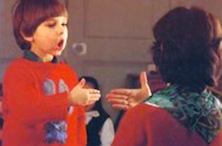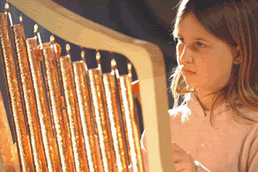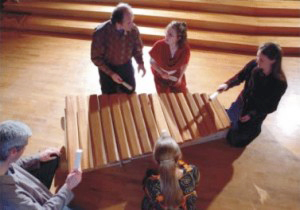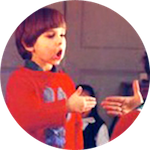 Children’s Vocal Development
Children’s Vocal Development
Whilst we have progressions for children’s musical and instrumental development, it is hard to find such developmental progressions regarding what we should expect in terms of children’s vocal development—namely what is NATURAL for their voices to do—or how to listen for the sounds of this development. Surely we should have concerns about this, given the goal of matching all aspects of children’s music making to their innate development?
Fortunately, some well known academics have researched and written up this question (e.g. Graham Welch, Leon Thurman and Carol Klitzke). Having said this, like much research it remains hidden away behind the doors of academia and struggles to find its way into classroom practice. So here, first of all, are some insights on the growth of children’s vocal anatomy – inspired by the book Bodymind & Voice edited by Thurman and Welch.
Laryngeal dimensions increase slowly and steadily in size and firmness throughout childhood. Likewise, the vocal folds increase their total length by about 6.5mm between the ages of 1 to 12. In the first few years of a child’s life, the vocal folds are made up primarily of mucosal tissue. Only around the age of 2/3 years old does the thyroarytenoid muscle—the vocal folds ligament—begin to develop which gradually gives the vocal folds more stability and structure. Consequently, only by age 10 are the vocal ligament and mucosal tissues considerably developed.
In the same vein, the vocal tract – which extends from the true vocal folds to the exterior surfaces of the lips – is also very short in early childhood. Until the age of 2 years the tongue lies entirely in the oral cavity, and then its base begins the gradual descent into the pharynx, so that by the age of 4, the posterior one third of the tongue is located in the pharynx. Only by age 5 is the basic adult configuration of the vocal tract present, but of course this does not mean it has reached its full size. Only by age 9 will the curved contour of the vocal tract be comparable with that of an adult, but even then it still remains shorter and smaller.
This tube (i.e. the vocal tract) has acoustic properties quite apart from the pitch and harmonics produced by the vocal folds. Sound waves that are emitted from the vocal folds pass through a series of linked containers (or resonators) and each contains its own timbre and sound quality. In fact each different sized resonator has different frequencies and amplifies particular overtones that are emitted from the vocal folds.
Therefore, in each phase of childhood the child’s voice has a distinctive and underlying anatomy which produces specific modes of singing, because the vocal folds, the larynx, the vocal tract, the resonators and the tongue of the young child are completely different from those found in adults’ singing. Clearly, this all causes a young child’s sung tone to have totally different qualities to those of an adult.
As an example of this, consider how, when children sing on their own—i.e. without adults—you can hear how their voices easily lift up into higher pitches and bright open timbres. But when children sing together as a class with an adult you often hear how they push their voice—called ‘pressed phonation’ by voice experts—which leads them to use a lower pitch range. In short, it is easy to assume that children sing in the same range as most non-specialist adult singers. (Note: Here’s the theme of the “adultification of childhood”.) Of course, when young children do not have good models to imitate you will hear how their pitch range is similar to that of an adult, namely, it is often found to be lower.
This situation is further exacerbated today by the fact that children in their early years primarily hear ‘popular’ singers using a type of singing called ‘belt voice’ which is based on a heavy, strong contact of the vocal folds. Such a very physical way of singing—which is fine for the energy and emotions that stand behind most ‘popular’ forms of music and for older teenagers—is wholly inappropriate for: pre-school children’s vocal instruments, and the open nature of pentatonic music. In this connection it is important to recognize how the type of voice use—or timbre—needed to match the inner qualities of pentatonic music is just as significant as the pitches and rhythms of pentatonic music.
 So what are the characteristic qualities of pre-school children’s voices based on their anatomy?
So what are the characteristic qualities of pre-school children’s voices based on their anatomy?
What you will hear are some of the following: a forward, light and bright resonance; higher light-filled frequencies full of high harmonics; open vowels and a wonderful etheric ring.
So what does all this mean for the practicing teacher?
Firstly, we need to be aware that the teacher tends to inwardly hear and recognize only the timbre of their own particular voice type. Thus we need to teach ourselves to hear other textures and colors of the voice outside the parameters determined by our own experiences. (See above.)
Secondly, we typically provide child-sized equipment for children and adjust tasks to their physical capabilities. Surely, therefore, this should also apply to singing? Sadly, however, this is seldom the case because teachers tend to look upon singing as a ‘natural’ activity which requires no conscious awareness on the part of the teacher. Alas, however, teachers’ voices are full of unhealthy and unconscious vocal habits which the children imitate.
Clearly, the development of children’s singing voices in their early years takes place primarily through the way they imitate the voice of the teacher. Thus it is crucial that teachers ask the question, “How can I provide an appropriate vocal model for the children to imitate?”
In particular, the teacher needs to develop their voice so that it can manifest:
- Etheric ring provided by the teacher’s work with ‘ng’ inspired by the Werbeck pathway
- Forward, light and bright resonance caused by the vocal folds being amplified by the nose, the sinuses and the hard palate (as opposed to the warmer, fatter, heavier resonance that adults typically use through the resonance of the pharyngeal tube). In addition this should take without recourse to any physical force, for when singing becomes just a physical activity the etheric tone that is natural in a child’s voice is lost. Moreover, such physical voicing represents the polar opposite to the open, labile, floating quality of pentatonic music in the mood of the fifth.
In addition, the teacher needs to be able to model the following vocal qualities:
- Lots of breath movement, good line and a strong sense of phrasing
- Open throatedness
- Legato articulation
- Clear resonant vowels
- Good use of the self (namely, a well balanced use of the body so that unnecessary movements – e.g. pulling the head back or tongue retraction – do not compromise the singing).
“It’s the Ear Which Sings” (Alfred Tomatis)
Whilst we all easily understand that children do not fully physically mature until puberty and beyond, we rarely ask questions such as, ‘does the structure of a child’s ear actually change throughout their maturation, or does the ear actually change the way it perceives because of the way the physical structure develops during maturation?’
It is clear from modern research that the younger the children are, the more they hear in higher frequency bands. This means that just as a cat or a dog responds to frequency bands that we do not hear, so a child in their early years hears overtones more clearly than we do as adults. Furthermore, in this connection, research clearly points to the way that babies, toddlers and pre-school children imitate the timbre, color or resonating properties of their teacher’s voice more than they do the outer pitch. That is, the teacher’s mode of voice production is more influential with regard to the children’s pitch matching skills than the actual note the teacher is singing.
Higher frequencies and overtones also play a big part in helping children focus the muscles of their middle ear. But what we find today is that the mechanisms involved in this focusing must be intact or it is difficult for children to match the pitch they are hearing with appropriate movements of the vocal folds. Thus Tomatis expressed great concern about the growing influence of electronic bass guitars—to this the author would also add the use of Walkmans and iPods, etc.—because of his concern that this was going to de-tune the responsiveness of children’s hearing. In addition, the tendency for adults to sing using pharyngeal resonance also leads to a tonal spectrum lacking in higher harmonics.
It is also my firm belief that “attention deficit disorder” today is clearly linked to this question, because the majority of children with this disorder find it very difficult to focus/concentrate their listening and attention on one signal in an aural environment because they are being disturbed by all the noises and sounds in the whole environment around them. This phenomenon is often the result of the damage done by the media they are using to listen to music.
It is also important to become aware of how SMILING when singing can influence hearing acuity because of the way the risorius muscle reaches out from underneath the lips on its way to the ears and actually stimulates the hearing process because of the stretch it receives in smiling. (This crucial insight comes from the work of Alfred Tomatis.)
 The Eustachian Tubes and the Larynx
The Eustachian Tubes and the Larynx
Up until approximately age 9, the child’s singing voice is primarily formed and influenced by the people who sing around them (e.g. parents and teachers). What we hear from the children voices is almost an echo of our own voice as if we were calling into a cave and hearing the echo come back. In other words the movements of the child’s larynx is formed by the way they imitate adult models. Indeed, I have frequently found that when children imitate poor adult models you can often set up vocal habits that can block their voices for the rest of their lives. How does this happen?
The child’s larynx is very flexible and receptive. Via the mediation of the eustachian tubes the larynx speaks to the ear and the ear speaks to the larynx. This inner to outer connection/pathway is much more open in young children’s anatomy than in an adult’s anatomy. It is therefore much more susceptible to the influence of our (adult’s) voices.
Whilst in one way you can say that the ear and the larynx are two individual organs, they also work very closely together. Thus it is important to look upon them as a unity. Because the ear and the larynx are not each enclosed within themselves like the eye, what enters through the ear influences the larynx and visa versa.
Whilst in one way you can say that the ear and the larynx are two individual organs, they also work very closely together. Because the ear and the larynx are not each enclosed within themselves like the eye, what enters through the ear influences the larynx and visa versa. Summing this up, Dr. Eugene Kolisko—who worked with Mrs.Werbeck and Rudolf Steiner on bringing etheric tone into voice work—said,
“Through the eustachian tubes the activity of hearing is conveyed inwards, as they connect the larynx to the ear anatomically and physiologically. Through this activity… the eustachian tubes make the two organs—ear and larynx—into a unity… When we hear someone speaking and he says the word ‘tree’, we speak the word ‘tree’, too, with our etheric body… it etherically resounds in the so-called eustachian tubes.”
(Note: This is also one of the reasons young children can learn languages so much quicker in their early years.)
In other words, what the child hears is inwardly accompanied sympathetically by their larynx. In short, the other person sings in me which brings with it a sense of the social and moral responsibility we bear in this realm.
With these thoughts in mind, it is now possible to explore the crucial importance of the vocal model the teacher provides for children to imitate.
How Does the Teacher’s Vocal Model Influence Children’s Pitching?
Pre-school children hear the sound/timbre of the teacher’s voice in the foreground of their consciousness—i.e. the vocal tract behavior of the singer—more than the pitch the teacher wants them to imitate. This can be hard for adults to understand because we hear in a completely opposite way, namely we focus on the pitch, not the timbre.
Over the years I have experimented with this question many times and found a significant correlation between children’s pitch accuracy and the quality of the vocal model the teacher is providing. In short, the pitch the teacher is offering can be obscured by many obstacles. For instance,
- ‘VIBRATO’ in the voice is a source of great confusion to young children because for them it is difficult to find the pitch within the wobbling tone of the vibrato.
- BREATHINESS/FREE AIR in the teacher’s voice distorts the tone and makes it difficult for the children to hear the centre of the pitch they are being asked to match.
- When a singer sings the same pitch but uses DIFFERENT FORMS OF RESONANCE (e.g. pharyngeal versus nasal resonance), then the pitches can sound higher and lower to a child. In addition, they can sound flatter and sharper and this has huge consequences for children’s capacity to hear a pitch and immediately reproduce it. In particular, the use of PHARYNGEAL RESONANCE – which characterizes many adults’ voice use and leads to tones that are full of deeper harmonics confuses many children. (The pharynx is the resonator that rises up from the level of the vocal folds to behind the eyes and is divided in vocal anatomy into the laryngeal pharynx, the oro pharynx and the nasal pharynx.) This means the higher harmonics typically found in children’s voices are missing and this tends to confuse children so they do not agree on the pitch.
- In addition, when it is sung LOUDER this can change the pitch for some children.
In short, the voice use and tonal quality of a teacher’s singing affects the child’s pitch discrimination. Thus poor tone quality on the part of the person teaching a melody often causes pitch inaccuracy.
In the main, as I said above, children’s voices are naturally more forward and brighter than an adult’s voice, because of the different dimensions of their vocal tract and the different size of their vocal folds compared to those of an adult.
What all specialists in this field would agree upon, is that pre-school children have the best chance of responding successfully to a given target pitch if the vocal model provided is as close as possible to the typical bright resonance and timbre produced by these children’s voices.
Thus it is crucial for the teacher to learn how to sing using a BRIGHT, FORWARD and UNPRESSED voice so that the sound is pinging off the resonators that lie forward an up from the vocal folds (e.g. the hard palate, the nose and the sinuses) rather than being hidden back and down in the pharyngeal tube.
 The Question of Male Teachers Teaching Singing to Children
The Question of Male Teachers Teaching Singing to Children
One of the questions I am most frequently asked is connected to the question of male singers teaching songs and singing to young children because their voices sound in a different/lower octave from both women’s and children’s voices. Thus male teachers often ask, “should I sing in my falsetto voice so that I sing the same pitch as the child?” My response to this would be to say “no”, because in order to sing in falsetto the vocal folds behave in a totally different way to those of children, not least because they are under much greater tension to those of a young child and we don’t want children imitating this form of voice use.
Consequently, the best advice I can offer for the male teacher – is to sing with light, forward, bright resonance, etc. and to play the actual start up notes on an instrument like a lyre or harp, as you simultaneously sing. Best of all, simultaneously play the pitches of the melody on the lyre as you sing, because the lyre plays in the same octave as the children’s voices sing.
The Teacher’s Singing Voice
Teachers need to take the quality of their own singing voice seriously, not least because it radiates a sense of their well-being—or lack of well-being—to the children. Children also need to sense their teacher is working on their own voice and how this is part of their self-development. (In my experience, teachers working on their own voices find how it can be a source of regeneration and health in their lives.)
Today, you can see how children are taught singing according to the idea that letting them just sing naturally is the right methodology. Of course, babies do sing correctly, so correctly, in fact, that adults should learn from them. Thus we should ask how can one help the child not to lose its right singing as he/she grows older? The answer to this is by providing the child with a wonderful culture of singing to imitate. But this means we must be a wonderful example to them with regard to singing in the first place.
Consequently, we need to be constantly vigilant concerning the HEALTH of the sound of the children’s voices – namely we need to wake up to questions of the role teachers have regarding “voice care”, because many children’s voices today sound either edgy, harsh, loud and pressed; or very thin and breathy.
What constitutes unhealthy voice use in the pre-school environment?
Above all the teacher needs to guard against the following unhealthy elements in singing:
- Pressed / pushed phonation
- (This leads to the “closed quotient” time the vocal folds stay together being too long which leads to fixity, a loss of movement, hardness in the voice and a sense of closure.)
- The use of breathiness / free air in the voice
- (Note: Many pre-school teachers deliberately add breath to their voices in a mistaken effort to make their voices lighter and more like what they perceive the children’s to be.)
- The use of pharyngeal resonance
- High shallow breathing
- Noisy intakes of breath which irritate the vocal folds, draw children away from the listening space, and cause shallow breathing
- Tongue retraction
- Vowels produced without the aid of the tongue and the lips (N.B. Many teachers erroneously think vowels are created in the laryngeal throat region.)
- Inflexible, monochrome dynamics
- Lack of breath flow through the phrase leading to syllabic note-by-note singing.
If you hear vocal problems or sounds that you do not understand why or how they are occurring, then I suggest trying to make that sound yourself as an imitative process, because this will often suggest the solution to you. ABOVE ALL, CONSIDER TAKING VOICE LESSONS YOURSELF!
Voices of Wonder and Awe
The sound of children’s singing today can lack brilliance, resonance and clarity. It can sound either very forced or very dull and cloudy. One of the big influences on this dullness and lack of luster in some children’s voices today is connected to the numbing external influences of the world upon both children’s (and adults’) lives. These influences can cause teachers to deaden their voices gradually over the course of their lives and this chips away at their human aliveness and vitality (and the aliveness and vitality of children’s voices).
In particular, the qualities of AWE and WONDER are lacking in the world in which we live, although Waldorf Kindergartens, of course, work hard to make sure children can encounter these qualities in their early years. So it is exactly awe and wonder that the children need to experience in music and their singing. Thus as James Jordan says, “awe and wonder are the only true vehicles for music making.”
Thus a central question I have is: “How can we awaken a picture of the WHOLE HUMAN BEING in singing?” This is a key question for teachers because at present you can only find PHYSICAL/ANATOMICAL, EMOTIONAL and SCIENTIFICALLY informed ways of working with the singing voice in singing teachers’ studios and school classrooms.
However, during the early years of the child (by this I mean up to approximately the age of nine), it is important that we do not draw their attention strongly to their physical body in singing via exercises that are designed to work on specific elements of vocal anatomy. Nor should abstract technical exercises divorced from the context of a song be countenanced. Where the teacher feels help needs to be given to the children’s voices it should be done via Pictures Stories Lots of Movement and Gesture Vocal Play and Improvisation – all of which should be connected to the songs being taught.
What is nearly not present at all is a sense of working with the “SPIRITUAL” and “ETHERIC” nature of the singing voice, namely working with a voice that manifests more than the personal subjective realm and more than the physical body.
Freeing the voice from the effects of today’s civilization– which is leading to an increasing hardening of the physical body – is truly important and meaningful work for any teacher. This work would hardly be known about at all were it not for the work of Jürgen Schriefer and Valborg Werbeck-Svärdström. Out of their awareness of these questions they created exercises to strengthen the etheric stream in both children’s and adults’ voices.
 Singing and the Etheric Body
Singing and the Etheric Body
Mrs. Werbeck’s School of Singing for Uncovering the Voice—validated by Rudolf Steiner—gives teachers a wonderful way of learning how to bring the etheric body into their voices in such a way that it sounds freely in the “listening space”. Given the importance of young children’s imitative capacities, it is vital that pre-school teachers learn how to bring their etheric body into sounding, not just their physical and astral bodies. (To go into this is beyond the scope of this article. In addition, one needs to work with a Werbeck trained singing teacher on the appropriate exercises which need both regular practice and feedback.)
In this connection, Dr.Eugene Kolisko said, “When children are allowed to sing at the top of their voices in school, they push the process of singing into the lower bodily organization. A kind of pressing together, a blockage occurs: this has a hardening influence on the ether-body… With the /ng/ singing the child swings the sounds upwards… widens the inner spaces of the head and releases blockages in the body.”
Note: At this point it is important for me to say that I recognize that all singing should not be about the spirit nature of the human being. Of course, we should also have feeling-full singing, as well as embodied voices, allied to joy and fun. But I am making a plea for a deeper spiritual understanding of singing, as this is so absent in singing pedagogy. In addition, we should recognize that a young child’s singing is naturally characterized by etheric and spiritual qualities, whereas adults’ voices are obviously heavier and more physical as well as informed by the more subjective sphere of our feeling life.
Pentatonic Music in the Mood of the Fifth and Its Implications for Singing
Reinhild Brass, in her booklet Singen in der Schule points out how the imitative forces of the child’s voice can truly be connected to the openness and lightness of the mood of the interval of the fifth. Thus, the pentatonic mood is a wonderful aid not only to children’s listening, musicality and the development of their consciousness, but it also aids their singing voices. Thus we can speak about learning to sing with a voice that matches the qualities of pentatonic music in the mood of the fifth. In short, pentatonic music is not just about pitches and rhythms, it is about the voice quality.
On the other hand, too early a use of the more inward intervals (e.g. the major and minor third which brings with it a new consciousness of the beat and human astrality) takes the child in a more interior direction and leads to an early loss of both their imitative capacities and the light, spacious free floating quality of their voices. In fact, you could say it removes their voices from the “listening space”/periphery. 

Michael Deason-Barrow (GRSM, ARCM) is director of Tonalis: Centre for the Development of Music. He has lectured in universities, been head of music in a London comprehensive school, taught in Steiner Schools and given the plenary lecture at the renowned Oxford Conference in Education. Recently he led the Waldorf Music Teachers’ Conference in Germany that takes place with 200 delegates, at the beginning of January each year, and is invited annually to teach the combined students from the Witten-Annen (Germany) and Helicon (Holland) Waldorf Music Teacher Trainings. Michael also delivered a module on ‘Music in the Pre-School Years’ for the Irish Steiner Kindergarten Association Early Childhood Education Program in the summer of 2010. Today he runs courses all over the world connected to a new vision of music education and leads a “Foundation Training” in music education.

Sorry, comments are closed for this post.